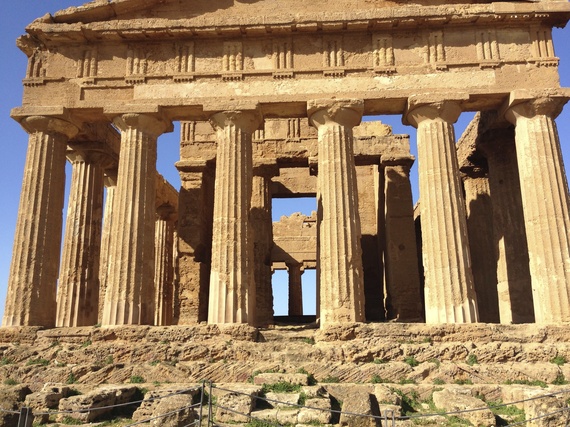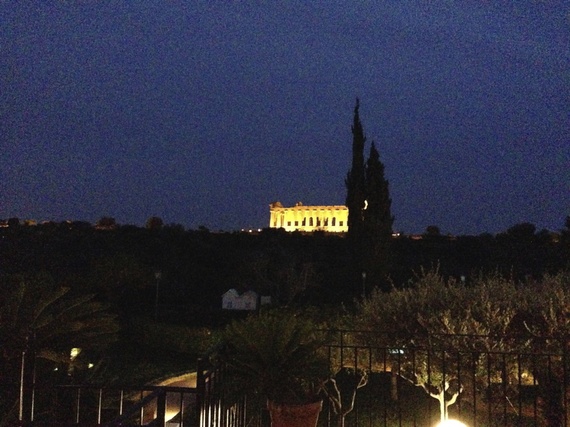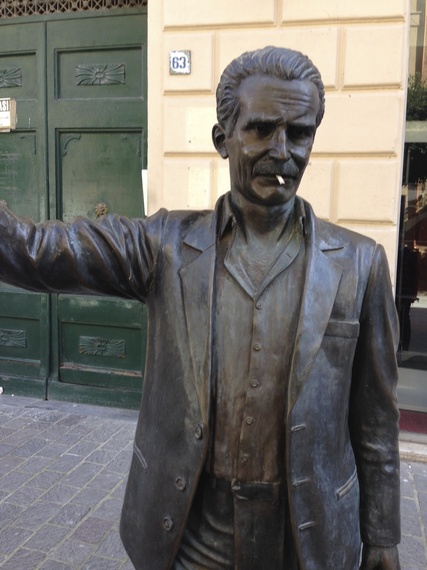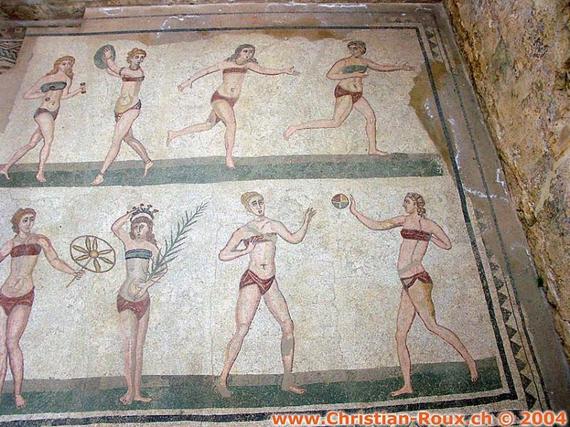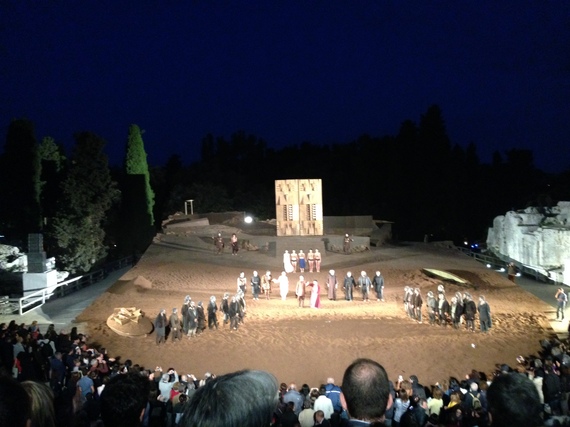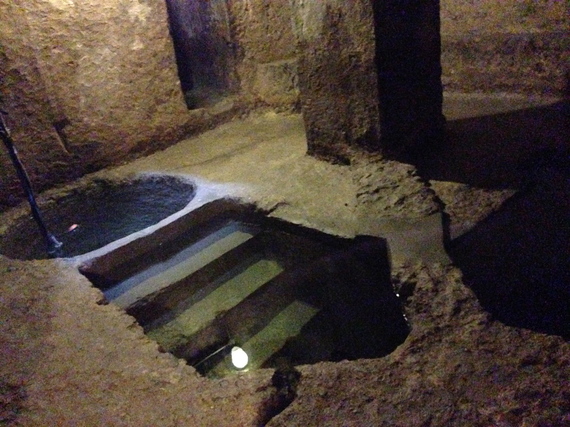Sicily continues to amaze me. The history here is so multi-layered and so ancient that I, from Boston with its proud and (very) young history, am overwhelmed and find it incomprehensible on many levels when faced with 8000 years or so of history.
From what I understand, this beautiful island was a destination for the many civilizations that had the ability to sail their vessels and take advantage of the favorable winds to get here. These ancient civilizations each left their marks, trading or conquering, making babies, creating temples and shrines.
Agrigento (located on an opposite coast from Siracusa and Ortigia) is astounding. At one time, the city/town had about 200,000 people and 15 Greek temples, and many of the temples (or parts of them) survive today. The Valley of the Temples is a wonderfully preserved treasure, with many temples testifying to the wealth and power of the Greeks (and giving evidence of their slaves who did the building) who lived and worked here. Some of the temples are illuminated at night, creating a view that did leave me breathless; the day time, close-up view is also just amazing and I could feel the history, the stories and the lives of those ancient times. I was told that no human sacrifices did take place here. I do know that the priests were the only people allowed in the inner sanctum and that the 'congregation' was always in front of the temple and not inside the structure itself. The temples are high on a bluff overlooking the sea, affording what must have been (and still is) a strong statement of the power and wealth and favor bestowed on the city by the gods and, also, serving as a warning to any possible invaders approaching from the sea.
Modern Agrigento is a bustling, fun, proud city, full of good food and interesting history. Authors Luigi Pirandello and Andrea Camilleri, among others, were born in Agrigento and considered it their home. Pirandello was actually born in a villa outside the city called "Chaos" (where his family and pregnant mother had sought refuge from a plague epidemic) and Camilleri actually used real places in Agrigento (renamed Vigata in his novels) for his hero Salvatore Montalbano to work in, live in and eat in. Since I have read and enjoyed the novels and seen some of the movies and tv shows that have been made from the books, I had a great time touring some of the actual sites with Michele, a great native guide. The Montalbano tv series is, supposedly, the longest running show in Italy, and still enjoys immense popularity; the food-obsessed and temperamental detective, full of personality and complications, makes wonderful comments about life in both Sicily and Italy. The city is proud of both the real author and the invented hero. Michele told me that 'the air, the sea, the view' in Agrigento all encourage and nurture creativity, as they have done for thousands of years.
And then there is the miraculous Villa Romana del Casale, located in-land here in Sicily, near the town of Piazza Armerina. This wonderful Roman villa (really a palace) was the summer home of a wealthy Roman general, and it was excavated by Paolo Orsi (a famous archaeologist) in the 20th century after having been buried under mud from an earthquake or mudslide for a long time. This villa is huge and very very well-preserved, showing the considerable wealth of the family and the imposing life-style they and their guests were accustomed to around the year 300 or so. The villa has over 40 rooms, and, miraculously, has incredible mosaic floors that are supposed to be the best example of 'in situ' (on-site) Roman mosaics in the world. Visitors are allowed to walk on plexiglass floors which afford an amazing view of the mosaics below, and the walk through the multiple chambers is outstanding and awe-inspiring, showing the various rooms where guests were formally and informally welcomed according to their status; the less important guests were confined to the outer rooms, and the more important ones were invited into more lavish and intimate rooms which were further into the heart of the villa. The real inner sanctum was reserved for the family, and there are suites which must have been for the children, filled with mosaics depicting stories and themes which are children-oriented and playful. The artistry is absolutely breath-taking, was created by African artisans, and shows (using only pieces of mosaic) facial expressions on the people and the animals of the stories; it is a masterpiece in so many ways, giving us a glimpse into the ancient world. The great hall, which is a huge long space, shows the complete story of the animals, hunted and captured (by slaves, probably) in the jungles of Africa, boarded on ships (by slaves, probably) and transported by sea and, ultimately, ended up in the Coliseum in Rome. The entire mosaic tells a complete story and gives us a wonderful glimpse into these ancient times and into the artistry that is still awe-inspiring. One of the most famous mosaics here is the so-called' Girls in Bikinis', showing young female athletes in their sporting attire and in competitions. Villa Romana del Casale is definitely a highlight worth seeing.
And then there is the Paolo Orsi (archaeologist) Museum in Siracusa, recently renovated and truly, truly outstanding. The collection of artifacts and art dates about 8000 years, to a time I cannot even begin to imagine. The artifacts have all been found in Sicily, and many of the sites from where they come have not even been completely excavated yet, so much more remains to be found, apparently. The tools, the vases, the ornaments dating from such ancient times are incredible, and my former naive conceptions about the crudity and ignorance of these ancient peoples were really wrong. Some of the vases and the jewelry and the adornments are still so very beautiful, and the designs and the utility of the art and artifacts are surprisingly sophisticated and eternal. The excavation sites are located throughout this amazing island, and some are right here in Ortigia or Siracusa and in neighboring towns, emphasizing once again the importance of this region to the development of civilization as we know it.
And, then there is the Neopolis Archaeological Park in Siracusa, a vast natural park filled with archaeological sites from different eras of Siracusa's history and considered one of the most important archaeological sites in Sicily and even in the Mediterranean. The natural topography is fascinating and includes remnants of Greek stone quarries, altars, houses, the Greek theater, the Roman amphitheater, the Orecchio di Dionisio (Ear of Dionysius - a huge slave-made cave with incredible acoustics) and more.
The Teatro Greco (Greek theater), site of plays in ancient times, still hosts the Greek tragedies (presented by INDA, the Italian national drama institute) every summer, and this is the 100th year of the modern stagings. Each night a Greek play is presented, in Italian, in this beautiful old setting to a packed house. This year the program includes Aeschylus's 'Agamemnon' and 'Eumenides' as well as Aristophanes's comedy, 'The Wasps'. Ticket prices vary from 26 to 60 euros per seat, and cushions are provided in the reserved seat section, making sitting on the original stone benches a bit more comfortable. I went to see "Agamemnon" one night a couple of weeks ago, and felt quite overwhelmed with the knowledge that I was sitting where ancient Greeks sat, watching a play that ancient Greeks watched; the experience was amazing and the production was beautiful and simultaneously old and new. The night was beautiful in so many ways - the sun was shining when we arrived at the theater, so it was warm when we sat down, and after the sun set the night turned cool and comfortable (and with no bugs!). The set was fabulous and the Greek chorus was incredibly animated, dancing and expressing their opinions and fears with their bodies as well as with their words (which, of course, I didn't understand anyhow). The 'floor' was covered completely in dirt, and the cast members rolled around and danced around and played around in the dirt, somehow adding another dimension to the words and actions. The play is timeless and the story is ageless; seeing it presented in this marvelous theater was a true gift.
More modern history (but still many centuries ago!) can be found everywhere in Sicily. In Ortigia, for example, Jews may have been part of the history for about 2000 years. One story is that the Jews were brought to Sicily as slaves by the Romans after they destroyed Jerusalem in the year 70, but rumors abound that the Jews were present even before then, mostly as traders and merchants.
By the Middle Ages, Jewish communities were flourishing in Sicily and were to be found in 50 towns across the island, including Palermo, Messina, Taormina, Catania, Siracusa, Agrigento and Agira, where they worked as cloth merchants, doctors, bankers, farmers, tradesmen and goldsmiths; there were, perhaps, as many as 100,000 Jews living in Sicily before they were expelled from the island in 1492 by its Spanish ruler, King Ferdinand.
The Jews that remained after 1492 faced execution unless they converted to Catholicism. At that time Siracusa's Jewish population was second only in size to that of Palermo and Jews accounted for a quarter of Ortigia's inhabitants. The mikveh (ritual baths used by religious women and men) in Ortigia is one of the many traces of Jewish communities on the island. It was unearthed in 1989 during restoration work on a medieval palazzo once owned by the Jewish Bianchi family.
The mikveh, which dates from the 6th century, lies 30 feet below ground under the Residenza Alla Giudecca hotel in the heart of what was once the town's Jewish quarter (the 'Giudecca') which also housed a synagogue. When the Jews fled into exile they filled the mikveh with rubble and sealed its entrance, concealing it from prying eyes, so it wasn't discovered until the 20th century. The mikveh dates from the 6th century and was in continuous use until the 15th century when it had to be abandoned.
